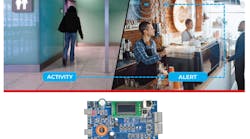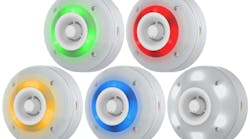For locksmiths who are involved with commercial locksmithing, access control and system integration, Von Duprin products should be a familiar and preferred name. Von Duprin has become the standard for exit devices and more recently electrically actuated hardware.
Recently we heard from a university locksmith who was extremely upset with the poor quality of another brand of exit hardware after several units in service on his campus literally "fell apart." He explained that the only way he could keep them on the doors was by using plastic bags and duct tape. He recalled the RFQ on a major student housing building project and switched the spec for the panic hardware to Von Duprin. This little episode speaks volumes for the sterling reputation Von Duprin enjoys.
Von Duprin was started in 1908, when it introduced the first "panic release bar" in response to a need for protecting life safety while providing security, a purpose that still guides the firm today. The product was marketed by Vonnegut Hardware Company under the name Von Duprin, (a contraction of Vonnegut, DuPont and Prinzler.)
The popular 88 Series crossbar exit devices still manufactured by Von Duprin have similar appearance characteristics to the original design, although significant engineering changes have been made.
Currently, Von Duprin manufactures a wide range of exit devices and outside trim operations, including rim-type and mortise lock, surface and concealed vertical rod, fire-rated and several electrical options.
The most innovative change took place in 1972, when the company introduced the first pushpad exit device, the Series 33. This new design could be electrified. Shortly after the 33 Series was introduced, the EL electric latch retraction version exit device was developed. Within the next few years, Von Duprin introduced the popular and versatile wide-stile pushpad 99 Series.
Series 33A/35A Exit Devices
Series 33A/35A exit devices incorporate proven design features and durability for the life safety conscious buyer. They are available in rim, surface and concealed vertical rod mounting for all types of doors, even door stiles as narrow as 1-¾". New design features provide improved security and life safety performance.
Finishes include Polished Brass, Dull Brass, Dull Bronze, Polished Chrome, Dull Chrome, Aluminum Anodized and Dark Bronze Anodized.
Design advances include:
- Deadlocking latch bolt standard on all device functions, providing greater security and durability.
- One-piece cover for stylish aesthetics and consistency of finish.
- Fire rated surface vertical rod device now available.
- Same device works on wood and hollow metal doors.
- Simplified concealed vertical rod adjustment for reduction of servicing time.
- Can fit on old device prep with minor modifications.
- Handing of lever trim can be done in the field with no extra parts, saving time and money.
Signal Switch: The SS (Signal Switch) feature signals unauthorized use of an opening. One internal switch monitors the touch bar and the latch bolt for positive security. A second internal switch is controlled by the key cylinder for alarm reset. The SS device is designed to work with additional alarm components.
Electric Latch Retraction: The EL (Electric Latch Retraction) devices provide remote locking control, useful where free-swinging doors are normally utilized. May be applied to fire devices when under the control of an automatic fire alarm system.
Request to Exit: The RX (Request to Exit) option is used to signal egress of an opening. These devices are equipped with one internal SPDT switch, which monitors the touchbar.
Latchbolt Monitor: The LX (Latchbolt Monitor Switch) option is used to signal both egress and access of an opening. These devices are equipped with one internal SPDT switch, which monitors the latch bolt.
ALK Alarm Kit: Exit Alarm Kits are simple yet effective ways to monitor the use of an exit. The unit contains an internal horn and operates on batteries.
Retrofits and Upgrades
Von Duprin bars lend themselves particularly well to retrofits and upgrades. On two recent occasions, we were required to upgrade existing Von Duprin exit devices, and we were able to modify the equipment without replacing it or compromising its listings.
In one situation, we installed a REX kit in an existing Von Duprin bar when the access control system required the installation of a card reader and electromagnetic lock. The exit device was equipped with classroom function outside trim. By installing the electromagnetic lock, the end-user achieved the flexibility of having both a positive latching and an always-locked outside lever if it became necessary so shut down entry on a door completely while not impeding egress. The REX kit upgrade requires disassembly of the exit device and the installation of a power transfer (in this case it is a signal transfer). For this project where only two conductors were being wired, an armored door loop was selected.
The other recent installation called for the upgrading of an existing Von Duprin surface-mounted vertical rod exit device with "Latch Retraction."
There are basically two ways a door with a Von Duprin exit device may be electrically actuated (controlled). First, use electrically actuated outside trim. When a signal is applied to the trim, the lever becomes "active" and turning the lever retracts the locking mechanism (latch or rods). A small amount of current is required.
Some applications will not permit the use of electrically actuated Trim. One example would be when the subject doors are also being opened by door operators. In that situation, the locks must be retracted before the door operators kick in.
Our project involved a pair of doors at a school which were equipped with Von Duprin exit devices with surface-mounted vertical rods. Theses doors were usually 'dogged down' during normal business hours, and they planned to continue this practice, even though a card reader was being installed. Electric Latch Retraction retracts the latch (or rods) when power is applied. The latch retraction feature has a 100 percent duty cycle, which means that the module is designed to remain energized for extended periods of time.
Installing the latch retraction module involves a few steps which may require both installation skill as well as a licensed electrician, depending on your particular job.
1- Remove the existing exit device assembly and replace the mechanical 'backplane' with the solenoid-operated unit.
2- Install a heavy-duty power transfer. (Refer to the Recent Locksmith Ledger Article on Power Transfers for a review of some of the options available) One additional option is available: the Von Duprin Electric Power Transfer. This unit is mortised into the hinge edge of the door and the jamb to provide a totally concealed (aesthetic and vandal-resistant) installation. It is supplied in two different versions, EPT-2 (2 #18 gauge conductors) and EPT-10 (10 #22 gauge conductors). Because of the infinite possibilities of installation conditions, you may be required to do what Von Duprin Tech Support refers to as some "field development." This means routing and perhaps fabrication of some brackets.
3- Install a Von Duprin Power Supply and connect it to line voltage (may require an electrician); to the power transfer (e.g. the exit device) and connect your card reader controller's dry contact output to the input of the Von Duprin Power Supply. The Von Duprin power supply may be purchased with a line cord which then means you need to be sure a line voltage receptacle is convenient located to the power supply.
4- Properly adjust the latch or vertical rods once everything has been reassembled and connected. Proper latch engagement with the rim strike and proper adjustment of the vertical rods with both the top trigger and bottom keeper are required for the exit device to not damage the floor over which it swings, to ensure that both the top and bottom rods properly engage, that the door will properly relock when the door recluses and that the exit device allows egress without requiring excessive pressure to be placed on the exit device to unlock it.
Our installation came out essentially perfect, on schedule and under budget. We were able to take a few steps back and admire our work, with the confidence that the system would provide security and reliable operation for many years.






